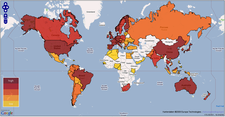Open Source World Map
In association with the Georgia Institute of Technology, Red Hat has carried out an open source index study and published it in the form of a world map.
The study ascertains the level of open source development in over 75 countries and measures the potential for the spread of free software in each land. Red Hat has given the project the name Open Source Index. More information about the study is available here as PDF and raw data can be downloaded from the Red Hat homepage. The study is available under the Creative Commons Attribution Share Alike License 3.0 (CC By SA). On its homepage, Red Hat encourages viewers of the study to come to their own conclusions.
From the gathered data, Red Hat has created two world maps. The Activity Map shows the level of actual active open source development present in each country, calculating an average value from the three areas of study, community, industry and government. France leads with first place in the government and third place in the community categories, with Spain and Germany closely following. The number one position in the community category was taken by Estland, followed by North America.
The Environment Map displays the amount of open source potential found in each country. Evaluating factors were among others; Internet penetration and the availability of technologies (patents). According to the study, Sweden has the greatest potential for open source development, followed by the USA, Norway and then Denmark.
Subscribe to our Linux Newsletters
Find Linux and Open Source Jobs
Subscribe to our ADMIN Newsletters
Support Our Work
Linux Magazine content is made possible with support from readers like you. Please consider contributing when you’ve found an article to be beneficial.

News
-
Mozilla Plans to AI-ify Firefox
With a new CEO in control, Mozilla is doubling down on a strategy of trust, all the while leaning into AI.
-
Gnome Says No to AI-Generated Extensions
If you're a developer wanting to create a new Gnome extension, you'd best set aside that AI code generator, because the extension team will have none of that.
-
Parrot OS Switches to KDE Plasma Desktop
Yet another distro is making the move to the KDE Plasma desktop.
-
TUXEDO Announces Gemini 17
TUXEDO Computers has released the fourth generation of its Gemini laptop with plenty of updates.
-
Two New Distros Adopt Enlightenment
MX Moksha and AV Linux 25 join ranks with Bodhi Linux and embrace the Enlightenment desktop.
-
Solus Linux 4.8 Removes Python 2
Solus Linux 4.8 has been released with the latest Linux kernel, updated desktops, and a key removal.
-
Zorin OS 18 Hits over a Million Downloads
If you doubt Linux isn't gaining popularity, you only have to look at Zorin OS's download numbers.
-
TUXEDO Computers Scraps Snapdragon X1E-Based Laptop
Due to issues with a Snapdragon CPU, TUXEDO Computers has cancelled its plans to release a laptop based on this elite hardware.
-
Debian Unleashes Debian Libre Live
Debian Libre Live keeps your machine free of proprietary software.
-
Valve Announces Pending Release of Steam Machine
Shout it to the heavens: Steam Machine, powered by Linux, is set to arrive in 2026.

